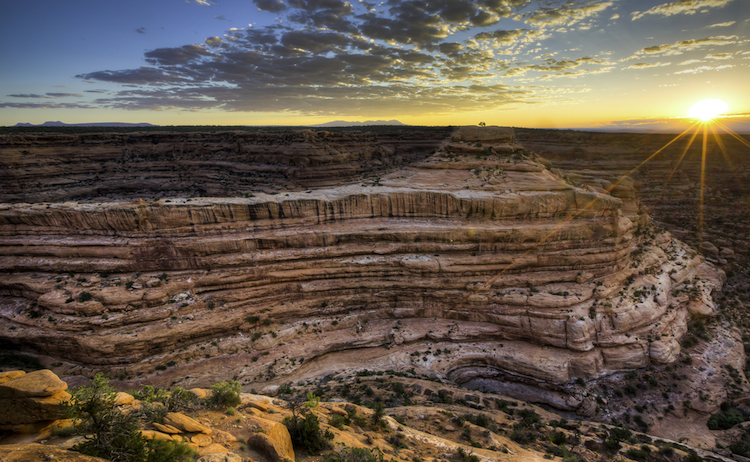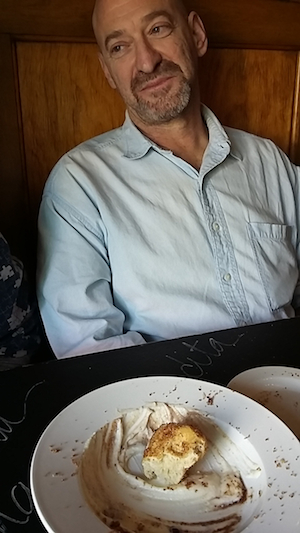Essay by Marc Nieson
Honest Impressions of the World

A few years ago, I went camping along the Comb Ridge in southeast Utah—old Anasazi land of sweeping slickrock and hard-cut canyons, twisted juniper and sharp shadows. Occupying one corner of Bears Ears National Monument, it’s a terrain stripped of anything superfluous by centuries of wind and wash, yet it conserves some of this country’s most significant archeological sites. It’s sacred public land, a remote area that’s still had to contend with the threat of individual looters. Bears Ears is also under review by the current Department of Interior, facing the loss of its federally protected status in order to serve wider private interests.
Luckily, my friends and I hiked for days without seeing another soul. Now and again, I’d spot some dried scat on the ground—mule deer and jackrabbit—or a glimpse of cougar’s tracks. An errant arrowhead.
Most of the human relics I glimpsed, however, weren’t underfoot but overhead, tucked in among eroded eyebrows in the rock face. Remnant dwellings clung to the cliffsides, cradling kivas and hardened corncobs, ceramic shards, chert. Ancient handprints marched across one ceiling, child-sized and tinted red. Chiseled glyphs of ladders and bear paws crept up another wall, with arrows and elk along the ground. Each one a clear sign etched into the stone.
Standing before the mute petroglyphs, I found myself conjuring stories about what lay behind each rendering. Elders teaching youngsters, as if on a blackboard? Bored lookouts whiling away the hours? Ancient oral myths made manifest? Yet, the more I gazed at these inscriptions, the more they struck me as precisely what they were—no different than anything else in the surrounding landscape. A rock, a bird, a sunrise.
Mostly I walked, and I looked. I listened. My journal lay nearly untouched, at most spattered with single words:
cedar—gully—manzanita—blue—arroyo—sage—summit—antler—breath
Sometimes, the world reduces itself to fundamentals, and so your language needs to be stripped clean, too, left free of any artifice. Sometimes, the imposition of story or metaphor or even an adjective feels like a conceit. A betrayal.
Walking along that angled slickrock, I became very aware of my weight and the pull of gravity. At the same time, I was aware of the raven soaring overhead and the echo of its cry. Of the returning silence in its wake. Of presence and passage. Content and context.
As a writer, I see my task as that of a craftperson, laboring hard to leave behind some lasting sign. I try to record tiny glimpses of my surroundings and my times, my witness. Some days, I call it my words; other days, my work. At best, what I hope to leave behind is an honest impression. To keep my fingers from meddling with what’s sacred in its own right.

Publishing Information
- Bears Ears National Monument (U.S. Forest Service website).
- “Honor Tribes and Protect Bears Ears” (Inter-Tribal Coalition website).
Art Information
- "Cedar Mesa Citadel Ruins" (Bears Ears National Monument) © Bureau of Land Management, photo by Bob Wick; Creative Commons license.
- "Indian Creek" (Bears Ears National Monument) © Bureau of Land Management, photo by Bob Wick; Creative Commons license.
 Marc Nieson is a graduate of the Iowa Writers’ Workshop and NYU Film School. His background includes children’s theater, cattle chores, and a season with a one-ring circus. His memoir Schoolhouse: Lessons on Love and Landscape came out from Ice Cube Press in 2016. He's won a Raymond Carver Short Story Award, earned Pushcart Prize nominations, and been noted in the Best American Essays series. He teaches at Chatham University in Pittsburgh, Pennsylvania; edits The Fourth River; and is at work on a new novel, Houdini’s Heirs.
Marc Nieson is a graduate of the Iowa Writers’ Workshop and NYU Film School. His background includes children’s theater, cattle chores, and a season with a one-ring circus. His memoir Schoolhouse: Lessons on Love and Landscape came out from Ice Cube Press in 2016. He's won a Raymond Carver Short Story Award, earned Pushcart Prize nominations, and been noted in the Best American Essays series. He teaches at Chatham University in Pittsburgh, Pennsylvania; edits The Fourth River; and is at work on a new novel, Houdini’s Heirs.
For more information, visit Marc Nieson’s website.
An earlier version of this TW piece, “Language, Stripped Clean,” appeared in the “Writer’s Block” blog of the Loft (April 4, 2014).
